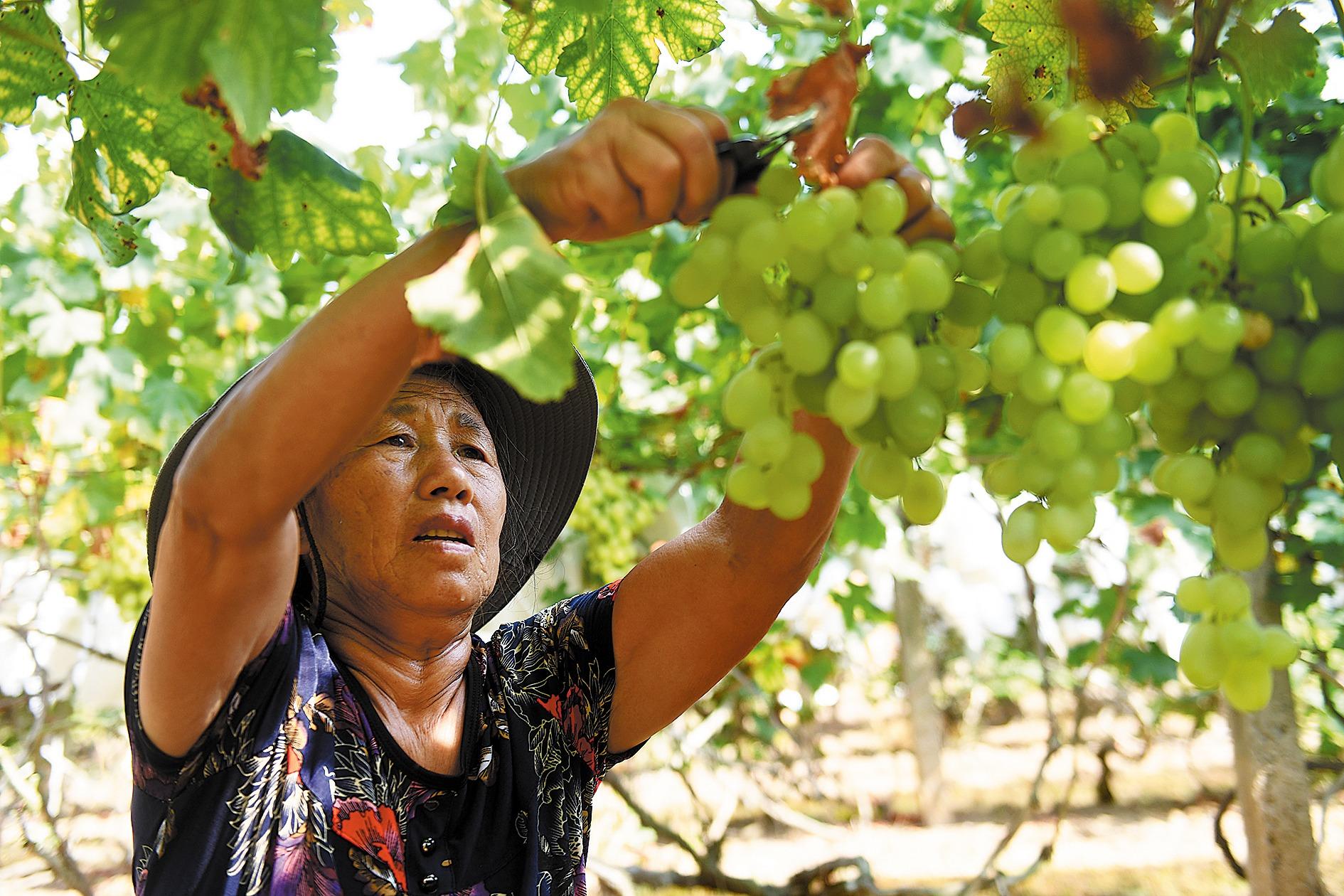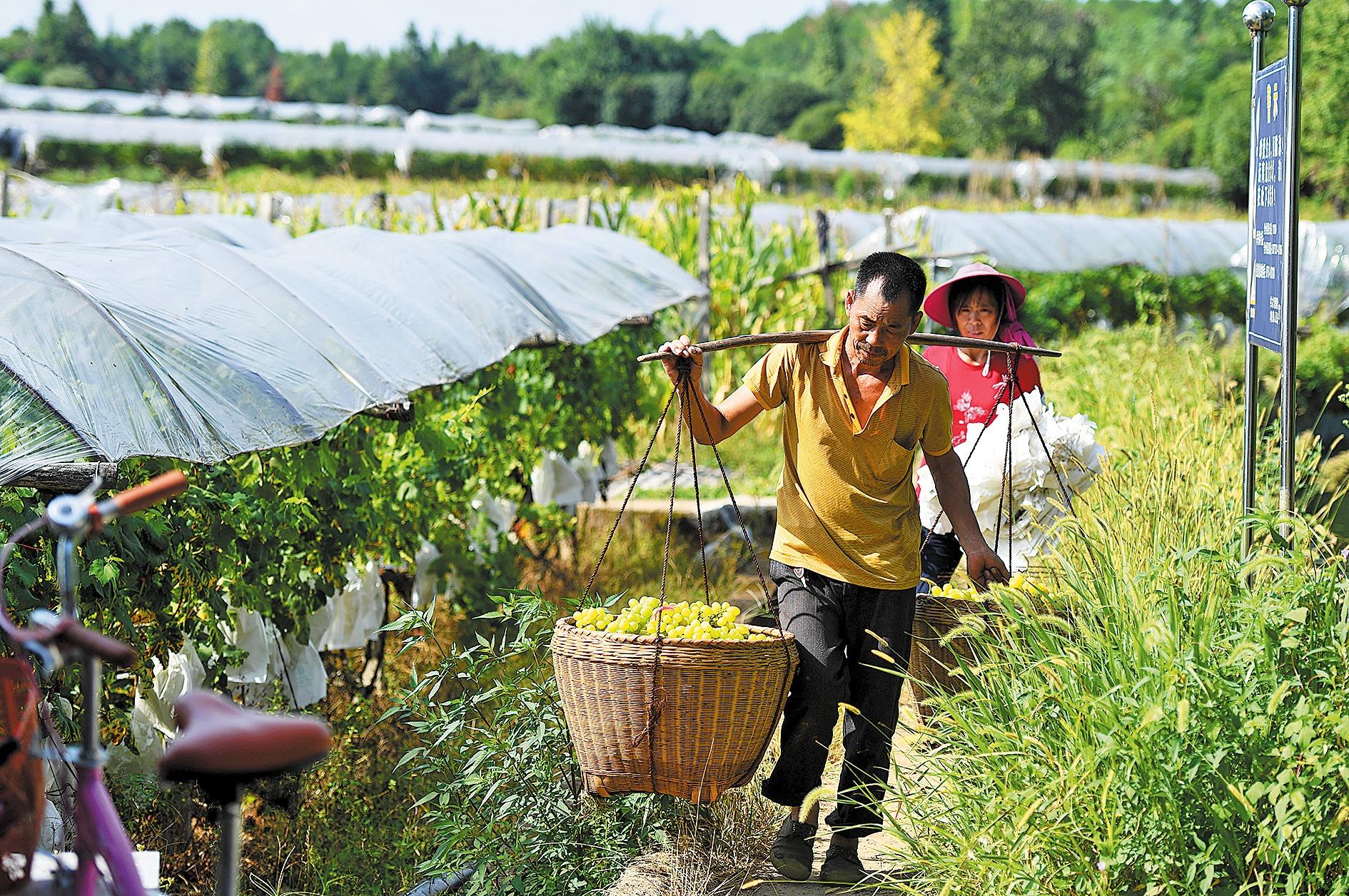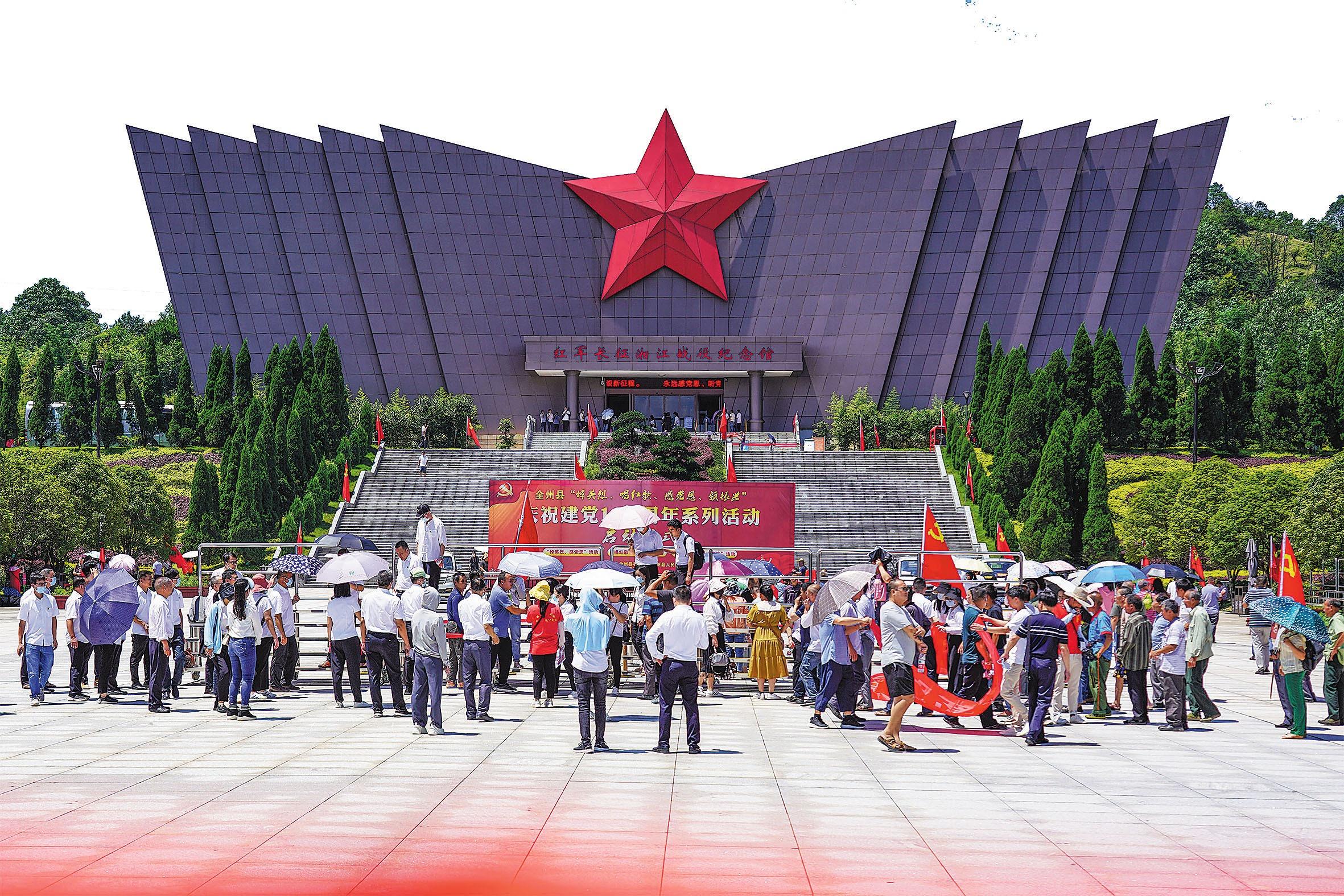City builds on Red Army legacy, blazes path of green development
 Visitors take a trip on the Lijiang River, which flows through Guilin, Guangxi Zhuang autonomous region. (PHOTO / XINHUA)
Visitors take a trip on the Lijiang River, which flows through Guilin, Guangxi Zhuang autonomous region. (PHOTO / XINHUA)
For Wang Deli, a 42-year-old grape grower in Guilin, Guangxi Zhuang autonomous region, the road to rural modernization is typified by his 0.87-hectare vineyard, where grape vines flourish in the spring sunshine.
Two years ago, President Xi Jinping visited Wang's home in Maozhushan village and chatted with the farmer's family during an inspection tour of the region.
Now, more certificates of merit for Wang's daughters, Wang Jia'nan, 13, and Wang Zixuan, 11, adorn one wall of the property, where shelves display local specialties such as packaged rice noodles, bottled sliced pepper and fried fish. Together with the vineyard they earned the family an annual income of 150,000 yuan ($21,550) last year, a rise of 10,000 yuan from 2021.
"We are sincerely grateful to the visit by President Xi, who encouraged us to live a better life through diligence and intelligence. I am now also running a homestay, one of six in the village," said Wang, who was elected a deputy to the Guangxi regional people's congress in January.
During his visit, Xi called for efforts to pursue rural vitalization based on local specialties and for the better use of science and technology to promote the agricultural sector.
 Visitors learn about the Xiangjiang River Battle at the Fenghuangzui ferry crossing in Guilin. (DONG JIDONG / CHINA DAILY)
Visitors learn about the Xiangjiang River Battle at the Fenghuangzui ferry crossing in Guilin. (DONG JIDONG / CHINA DAILY)
Grapes were first grown in Maozhushan, a once-impoverished village covering an area of 60 hectares and with a population of 156, in 2002. Many young villagers who moved to big cities as migrant workers gradually returned and were employed in the grape industry.
Wang Xinming, the village chief, said vineyards in the village now cover more than 21 hectares and can produce over 500,000 kilograms of grapes annually, generating revenue of more than 3.5 million yuan each year. The villagers' per capita disposable income reached 38,000 yuan last year, he added.
Moreover, Maozhushan has become a well-known destination for rural tourism. Wang Qing, a local tour guide, said that last year the village received more than 300,000 visits from tourists.
With help from technicians at the Guangxi Academy of Agricultural Sciences, the villagers have also started planting high-quality grape varieties such as Shine Muscat and Queen Nina, which are much more expensive than ordinary varieties.
Wang Deli said he planted the new varieties on about 20 percent of the land in his vineyard and will gradually expand the growing area. Newly installed drip irrigation equipment significantly reduces the production cost compared with a traditional irrigation system using pipelines, said the farmer, who expects a bumper harvest in August.
 Farmers harvest grapes at Maozhushan village, Guilin. (PHOTO / XINHUA)
Farmers harvest grapes at Maozhushan village, Guilin. (PHOTO / XINHUA)
Development plan
The changes made in Maozhushan epitomize Guilin's efforts to promote the integrated development of tourism, rural vitalization and culture in recent years.
The city, renowned for its mountains and beautiful rivers, has made full play of its advantages in areas such as tourism, agriculture and cultural heritage to advance on the path to modernization.
During this year's five-day May Day holiday, which started on April 29, the city received more than 4.35 million visits by tourists, and its tourism revenue reached 4.57 billion yuan, rises of 130 percent and nearly 126 percent, respectively, compared with the same period in 2019, the city's culture and tourism bureau reported. Both rises were higher than those at national level during the holiday.
This achievement has been attributed to the local government's efforts to strengthen ecological protection and build Guilin into a world-class tourist destination, as required by President Xi.
While inspecting a section of the picturesque Lijiang River in the city on April 25,2021, Xi, who is also general secretary of the Communist Party of China Central Committee, hailed the waterway as the one-and-only treasure in China and the world, and emphasized protection of the river's ecological environment.
The river used to be severely polluted due to quarrying, sand mining and sewage discharge, but its water quality has greatly improved. A total of 5.49 billion yuan was earmarked for a three-year ecological restoration project for the waterway, which started last year. Nearly 900,000 square meters of former illegal sand mining sites were readapted for use elsewhere. Last year, the authorities in Guilin designated April 25 as Lijiang River Protection Day to improve local residents' awareness of ecological protection.
Moreover, the city announced in January last year that the scenic area of Xiangbishan, or Elephant Trunk Hill, which Xi visited on April 26, 2021, during his inspection trip, would open free of charge to visitors.
Xi praised the move during a group discussion with the Guangxi regional delegation at the 20th CPC National Congress in October, citing the fact that tourism revenue in Hangzhou, Zhejiang province, rose, rather than fell, after the city canceled entrance fees for tourists to its landmark West Lake.
Dabitou International Tourist Resort in Quanzhou county serves as an example of Guilin's development strategy of integrating tourism with rural vitalization.
After the resort was established in October 2019, residents of Dabitou, a former hillside village, worked at the resort, which features residential buildings from the Ming and Qing dynasties (1368-1911) and recreational facilities such as hot springs, light shows and ecological farms.
With total investment of 5 billion yuan, the resort enables tourists to experience activities such as camping, rice planting and feeding spotted deer — offering an idyllic rural lifestyle. During the May Day holiday, the resort received more than 29,500 visitors and recorded revenue of over 1.26 million yuan, Guilin culture and tourism bureau data show.
 Farmers harvest grapes at Maozhushan village, Guilin. (PHOTO / XINHUA)
Farmers harvest grapes at Maozhushan village, Guilin. (PHOTO / XINHUA)
Red tourism
Guilin has also built on its status as an important revolutionary site, where a large number of Red Army soldiers died 88 years ago in a heroic battle along the Xiangjiang River. The city has also blazed a trail for the integrated development of tourism and revolutionary heritage resources.
In Quanzhou, the Xiangjiang River Battle Memorial Hall, which is about 5 kilometers from Maozhushan, has welcomed more than 14 million visits since it first opened in September 2019. The hall was named a base of Party and national historic education in 2021.
During the seven-day battle in November 1934, the Red Army, which was outnumbered by Kuomintang forces armed with much better weaponry, fought fearlessly against enemy forces while experiencing significant losses. Red Army members, with an average age of 20, were reduced from 86,000 when the Long March started in October that year to 30,000.
Jiang Chengbo, a narrator at the memorial hall, said the battle, which centered on control of three key ferry crossings along the Xiangjiang River, was so fierce that the bodies of fallen Red Army soldiers piled up in the water, turning it red. He added that according to a local saying, Guilin residents vowed after the battle not to drink water from the river for three years and not to eat fish from the waterway for 10 years in memory of the Red Army.
When Xi visited the memorial hall on April 25, 2021, he paid his respects to revolutionary martyrs. He said the Xiangjiang battle was a heroic battle of the Long March and an important historical event that determined the "life or death" of the Chinese revolution. In the face of even greater difficulty, one should think about the Long March and the battle, he said, adding that revolutionary beliefs should be carried forward.
Huang Gexin, a professor of Party history studies at the Party School of the Guilin CPC Committee, said the battle laid a solid foundation for the Zunyi Meeting in January 1935, which established Chairman Mao Zedong's leadership role in the Party and pointed the Chinese revolution in the right direction. Despite its large number of casualties, the Red Army's backbone forces survived, including dozens of commanders who later became major Party and State leaders, Huang said.
All-out efforts are being made in Quanzhou to build a section of the Long March National Cultural Park, which stretches across 15 provincial-level regions along the route of the 12,500-km epic Long March. The project will connect three key ferry crossings along the Xiangjiang River — Daping, Fenghuangzui and Pingshanwith a pedestrian walk as part of the nation's efforts to promote red tourism. Construction of the national cultural park is expected to be completed by the end of this year.
 Visitors pay their respects to revolutionary martyrs at the Xiangjiang River Battle Memorial Park. (PHOTO PROVIDED TO CHINA DAILY)
Visitors pay their respects to revolutionary martyrs at the Xiangjiang River Battle Memorial Park. (PHOTO PROVIDED TO CHINA DAILY)
Osmanthus city
In addition to its picturesque landscape and revolutionary legacy, Guilin, which literally means "forest of osmanthus" in Chinese, is known as a production base for osmanthus flowers, which have been planted in the city for more than 2,500 years.
The osmanthus was named Flower of the City in 1984, and Guilin is now home to 14,000 hectares of the plants and produces 10,000 metric tons of them annually, accounting for 60 percent of the national output and generating revenue of 3 billion yuan, Guilin forestry and garden bureau data show.
Guilin has also built a complete industrial chain that integrates osmanthus plantation, processing and tourism. In the city's Xiufeng district, the Osmanthus Commune, a national AAAA (the second-highest level) scenic zone themed on osmanthus culture, has received more than 170,000 visits since it first opened in April 2021.
Chen Yanhong, general manager of the commune, said his company aims to make osmanthus-related products, including cakes, tea and liquor, a signature specialty of Guilin, like flower cake in Yunnan province and pineapple cake in Taiwan. He added that he hopes more tourists from around the world will learn about Guilin's osmanthus culture through the commune.
Local delicacy
Along with osmanthus products, packaged rice noodles are another "must" for tourists visiting Guilin to take home.
Tan Huiyue, head of the Guilin Rice Noodle Industry Association, said there are nearly 3,000 rice noodle restaurants in the city, with more than 1 million bowls of the noodles sold every day.
In May 2021, Guilin's rice noodle-making technique was added to the national intangible cultural heritage list.
Huang Hai, chairman of the Guilin Gourmet Association, said that compared with the luosifen, or river snail rice noodles, of Liuzhou and the laoyoufen, or old friend rice noodles, of Nanning, which are also in Guangxi, Guilin rice noodles are cheaper but have richer ingredients.
In 2019, the city government issued a guiding document to promote the development of Guilin's rice noodle industry. The city is expected to build a complete industrial chain for rice noodle production by 2025, and the value of the industrial chain will reach 20 billion yuan, the document states.
Huang said the government should make more efforts to standardize the city's rice noodle industry, publicize the brand of Guilin rice noodles and encourage local businesses to set up more branches nationwide.


